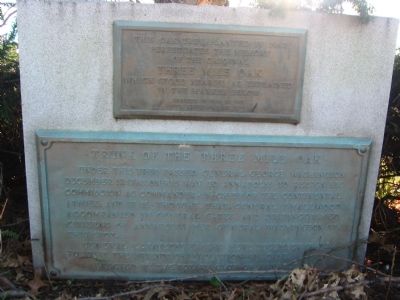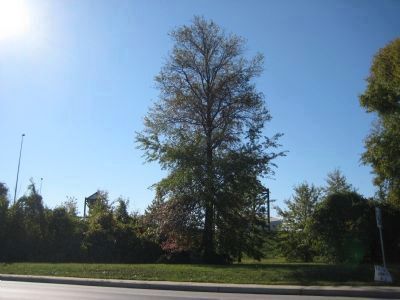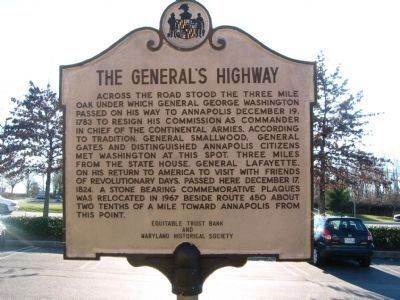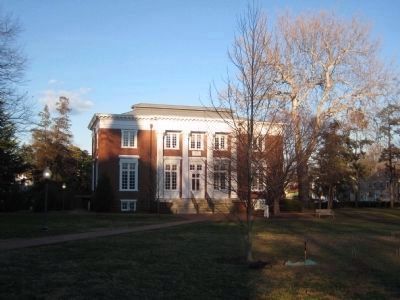Parole in Annapolis in Anne Arundel County, Maryland — The American Northeast (Mid-Atlantic)
Trunk of the Three Mile Oak
Lower Plaque: Trunk of the Three Mile Oak
Under this tree passed General George Washington December 19, 1783 on his way to Annapolis to resign his commission as Commander-in-Chief of the Continental Armies; and it is thought that General Smallwood accompanied by General Gates and distinguished citizens of Annapolis met General Washington at this spot. General Lafayette passed here December 17, 1824 to visit the friends of the revolutionary days.
Erected by Four Rivers Garden Club, Rotary Club of Annapolis.
Topics and series. This historical marker is listed in these topic lists: Colonial Era • Government & Politics • Military • Patriots & Patriotism. In addition, it is included in the Former U.S. Presidents: #01 George Washington, the Lafayette’s Farewell Tour, and the Rotary International series lists. A significant historical date for this entry is December 19, 1852.
Location. 38° 59.075′ N, 76° 32.676′ W. Marker is in Annapolis, Maryland, in Anne Arundel County. It is in Parole. Marker is at the intersection of West Street (Maryland Route 450) and John Hanson Highway (U.S. 50), on the right when traveling east on West Street. Marker is not easily seen from MD 450 as it is approximately 50 feet from roadway in the middle of “cloverleaf” area between US 50 overpass and MD 450 ramp to US 50, and hidden in the shadows of the oak tree behind it and the bushes to its left and right. Touch for map. Marker is at or near this postal address: 183 Jennifer Rd, Annapolis MD 21401, United States of America. Touch for directions.
Other nearby markers. At least 8 other markers are within one mile of this marker, measured as the crow flies. The General’s Highway (approx. 0.2 miles away); Camp Parole (approx. half a mile away); Political Representation in Ward Three, Parole (approx. 0.8 miles away); You Are Here (approx. 0.8 miles away); Mount Olive African Methodist Episcopal Church (approx. 0.8 miles away); Cecil Memorial United Methodist Church (approx. 0.9 miles away); Parole Health Center (approx. one mile away); Parole's Public Schools (approx. one mile away). Touch for a list and map of all markers in Annapolis.
More about this marker. The bottom brass tablet was originally located two-tenths of a mile further west on West Street at its intersection with Generals Highway (MD 178) and Defense Highway (MD 450). It was moved to its current location in 1967 to protect it from the growing road traffic. This tablet is the same one pictured in Horydczak and Besley photos below, on the concrete block beneath the trunk. The block remains at its original location. On the opposite side of the road from the site of the Three Mile Oak and original marker is a more modern historical marker erected in 1973
when the Equitable Bank and Annapolis Mall were built.
Regarding Trunk of the Three Mile Oak. The Three Mile Oak got its name because it stood three miles from the Maryland State House. Up through the early 1900s, prominent Annapolis citizens frequently met distinguished visitors at the Three Mile Oak and escorted them into town.
In 1783, Annapolis was acting as the capital of the American colonies, hosting the Continental Congress in the state house building. Having just won independence from Britain, many Americans were debating the form of government the new country should take. Local tradition holds that the occasion of Washington's passing under the tree on December 19, 1783 - where he was met by generals of the Revolutionary War - was at least one of perhaps many at which he was asked to become the king of a limited monarchy. Washington rejected the idea and continued with his plans to retire to private life, which he began when he resigned his Commission as Commander-in-Chief of the Continental Army, in Annapolis, four days later, on December 23, 1783.
Additional commentary.
1. About the Three Mile Oak
"Presumably a white oak, about six feet in diameter, located three miles from Annapolis, Anne Arundel County. A delegation met George Washington here on 12/17/1783, enroute to Annapolis (then the U.S. capitol) to resign his commission. A piece
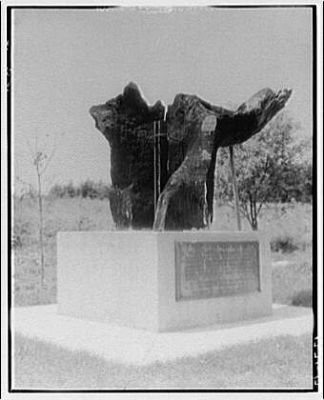
Photographed By Theodor Horydczak, c.1950
3. Library of Congress Photo
This photograph from the Library of Congress is titled "Sculpture of trunk of Three Mile Oak", but is the actual trunk, not a sculpture. After the tree finally blew over around 1900, local citizens had a concrete block built at the site of the tree and mounted the remaining pieces on it with a central shaft and supporting rods. The central shaft can just be made out in the photo. Photo credit: LOC, Prints & Photographs Division, Theodor Horydczak Collection, LC-H813-1271-012.
From Great Eastern Trees, Past and Present, by Colby B. Rucker, February 2004 (http://www.nativetreesociety.org/ bigtree/great_eastern_trees.htm)
— Submitted October 11, 2007, by Kevin W. of Stafford, Virginia.
2. Eva Dorsey Carr Gasperich
Looking through old copies of The Evening Capital, Annapolis' daily newspaper, I found several articles authored by Eva Dorsey Carr Gasperich and others on the subject of the Three Mile Oak. Mrs. Gasperich fondly remembered stories she was told by her grandparents and others about the importance of the Three Mile Oak in local and national history. In the mid 1900s she was trying to help raise awareness of original Trunk of the Three Mile Oak marker and the need to protect it from encroaching business and traffic. The marker was eventually moved to a new location in 1967. Mrs. Gasperich died in 1969.
In February of 1958, her poetic, two-part series about the tree envisioned Susquehannah and Piscatawey Indians making treaties of war and peace under its branches, Annapolis' founders meeting to establish Maryland's new capital, George Washington surveying the end of a new road from Williamsburg to Annapolis, farmers and planters debating British taxes, and finally
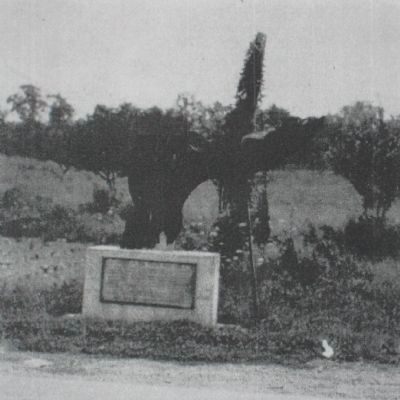
Photographed By Fred Besley, c.1950
4. Trunk of the Three Mile Oak
This photo was copied from Fred Besley's 1956 version of his book "Big Tree Champions of Maryland". The photo is included in the back of the book without comment. Locals claimed it was up to 250 feet tall, certainly an exaggeration given that current White Oak champions in Maryland are around 125 feet. But this photo shows a little more of the surrounding area in the early-mid 1900s which is clearly still rural in nature, despite its proximity to the state capital. Approaching Annapolis from the West with its enormous branches hanging over the roadway, the Three Mile Oak must have made quite an impression.
— Submitted February 23, 2008, by F. Robby of Baltimore, Maryland.
3. Herbert Hoover
Elmer M. Jackson, Jr. wrote a piece for The Evening Capital in Annapolis the day after the trunk of the Three Mile Oak was removed from its original location in November of 1967. In the article, Jackson recalled the last time the tree location was used to greet a visiting dignitary:
The oak was last used as an official meeting place during the administration of President Herbert C. Hoover. The Mayor of Annapolis, then Walter E. Quenstedt, members of the City Council and other municipal officials gathered at the oak to welcome Hoover on his visit to Annapolis for an engagement at the Naval Academy. They arrived early after making arrangements with the White House for a handshaking ceremony.
To the amazement of the Annapolis contingent, Hoover's motorcade moved pass the astonished Annapolitans while travelling at a speed estimated at 60 miles
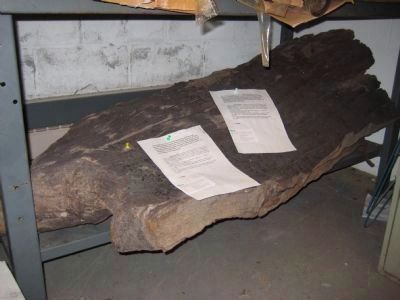
Photographed By F. Robby, November 21, 2007
5. Remains of the Trunk
The remains of the trunk (about 4-5 feet long) of the Three Mile Oak are stored in the Careers Building of the Anne Arundel Community College in Arnold, Maryland. This part of the trunk is the left portion of the trunk in the Horydczak photo. This piece was treated with a preservative when the college received it in 1988, and it has been stored ever since in a closet - it is not on display. Prior to 1988, Colby Rucker kept the trunk in his tobacco barn. The school is renovating the Careers Building in 2008 and will probably be moving the trunk to another location.
Quenstedt, a Republican presiding over a city council that was predominately Democratic, took quite a ribbing over the President's "slight", particularly because Hoover also represented the G.O.P.
Years later, we mentioned the incident to Hoover when he was in Florida aboard his yacht, and while along in years the former President was still able to keep three secretaries on the hop. He only smiled when we reminded him of his hurried trip from Washington to Annapolis. He was a delightful gentleman.
— Submitted February 23, 2008, by F. Robby of Baltimore, Maryland.
4. Three Mile Oak Fire Stories
Colby Rucker (Additional Comments #1) summarized the destruction of the Three Mile Oak, which was “struck by lightning, became hollow, was killed by fire, and finally blew down on 5/22/1909." I’ve been searching for historic references to the fire and the eventual toppling of the tree, but so far have only come across a few interesting stories told much later.
In 1954, Richard
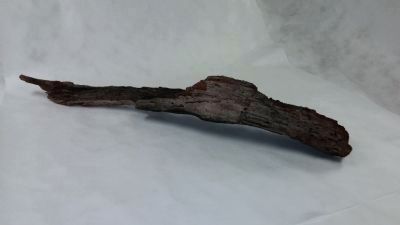
Photographed By F. Robby, August 14, 2014
6. Branch of the Three Mile Oak
This is a branch of the Three Mile Oak about 3-4 feet in length. The remains of the tree, including this branch and the trunk from the photo above, were transferred to the collection of the Maryland State Archives in Annapolis in 2012.
Eva Dorsey Gasperich tells in 1958 that the tree “went up in a pillar of fire one bitter, blowing winter night in early 1900.” She blamed the fire on a tramp using the hollow tree for shelter, heating his “stolen beans” and warming up his feet. All that was left the next day was a quarter of the charred trunk. It’s not clear if she was remembering the fire, the later wind, or both. The tramp story may be influenced by the fact that the area around Three Mile Oak was frequented by “hobos” and “gypsies”. In the late 1800s and early 1900s, several newspaper references can be found of bands of gypsies camping near Three Mile Oak, but they were cautiously reported as being “quiet, orderly people [who keep] to themselves during their stay.”
In 2007 while looking for the remains of the trunk at Anne Arundel Community
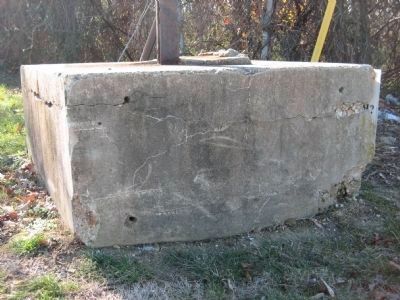
Photographed By F. Robby, December 18, 2007
7. Concrete Block
This is the concrete block, built by Frank Gilliam some time in the 1910s or 1920s, that still stands at the original site of the Three Mile Oak alongside MD 450 at its intersection with Generals Highway (MD 178). The holes on this side of the block once held the lower brass tablet titled "Trunk of the Three Mile Oak".
— Submitted February 24, 2008, by F. Robby of Baltimore, Maryland.
5. Remembering three mile oak stump
I remember seeing an old hollow stump on the concrete block in the 1974 to 1979 time. I used to work near the site of the new bowling alley in building that burned down in December of 1979. I would get lunch from the liquor/deli store
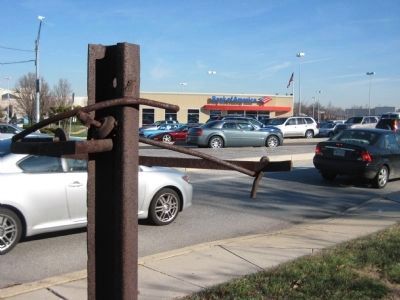
Photographed By F. Robby, December 18, 2007
8. Site of the Three Mile Oak
This photo of the intersection of MD 450 and Generals Highway shows the massive change in scenery from the Horydczak or Besley photos. The rusty post and rods in the foreground that used to support the trunk still stick out from the top of the concrete block. Beyond the passing traffic is the Bank of America (former location of the Equitable Bank) where a newer Three Mile Oak marker is located. This area of Annapolis used to be referred to as "3 Mile Oak", but is now simply known as the home of the Annapolis Mall.
— Submitted July 1, 2015, by Aubrey Francis Patterson of Annapolis, Maryland.
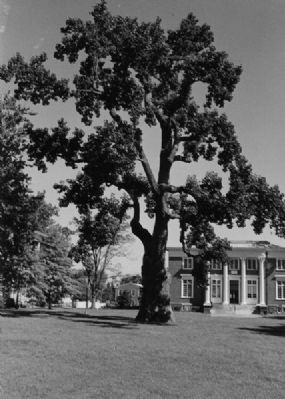
undated
10. Liberty Tree
The Liberty Tree on the campus of St. John's College is another historic Annapolis tree from the time of the Revolution. See Additional Comments #4 above for a tie-in with the Three Mile Oak. The Liberty Tree was taken down in 1999 after damage from heavy winds. Photo credit: www.stjohnscollege.edu.
Credits. This page was last revised on September 9, 2023. It was originally submitted on October 9, 2007, by F. Robby of Baltimore, Maryland. This page has been viewed 6,181 times since then and 96 times this year. Photos: 1. submitted on October 9, 2007, by F. Robby of Baltimore, Maryland. 2, 3. submitted on November 30, 2007, by F. Robby of Baltimore, Maryland. 4. submitted on February 23, 2008, by F. Robby of Baltimore, Maryland. 5. submitted on November 30, 2007, by F. Robby of Baltimore, Maryland. 6. submitted on September 1, 2014, by F. Robby of Baltimore, Maryland. 7, 8. submitted on February 23, 2008, by F. Robby of Baltimore, Maryland. 9. submitted on October 9, 2007, by F. Robby of Baltimore, Maryland. 10, 11. submitted on February 24, 2008, by F. Robby of Baltimore, Maryland. • J. J. Prats was the editor who published this page.
Editor’s want-list for this marker. Period photo of the tree, and of the intersection where it stood. • Can you help?
